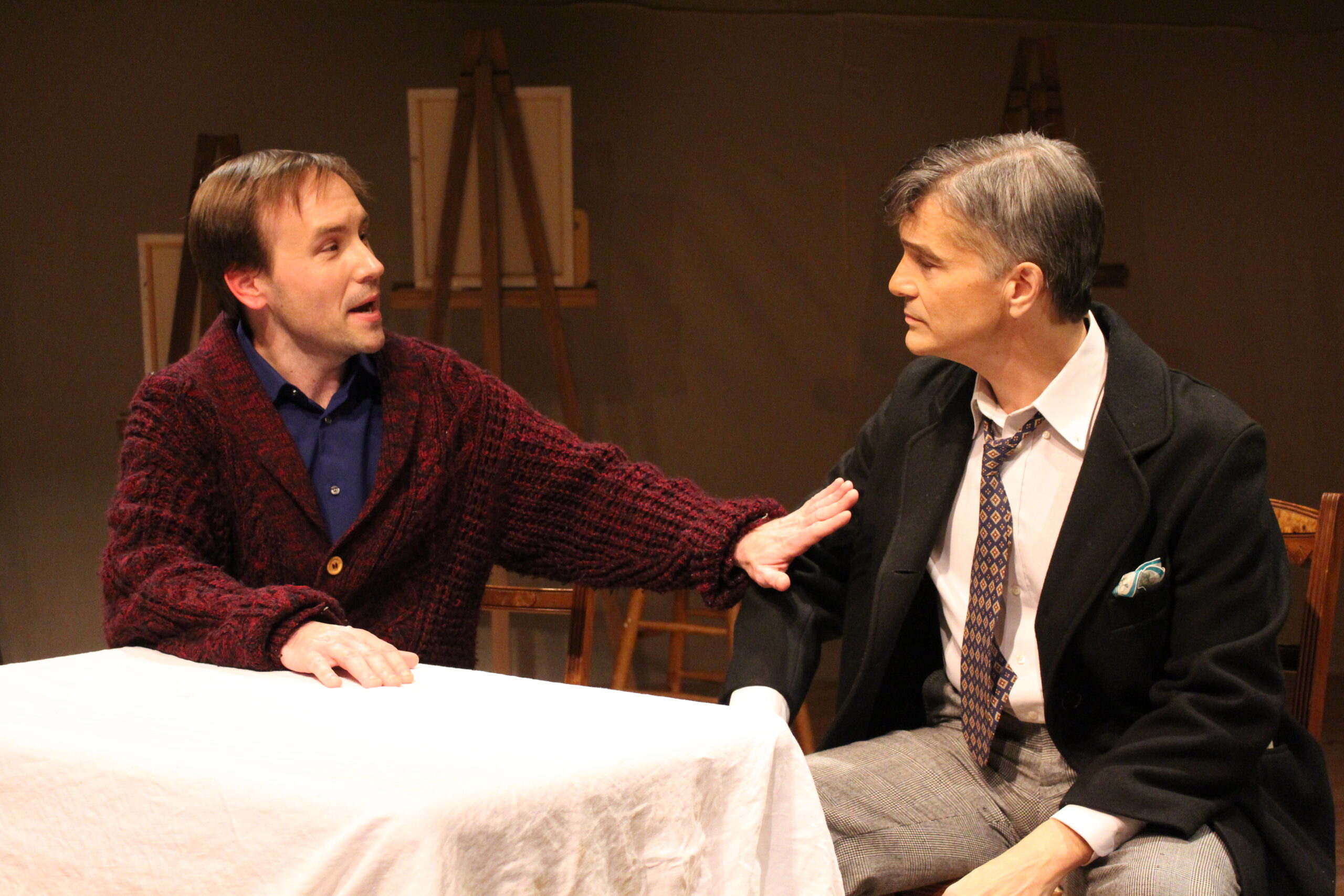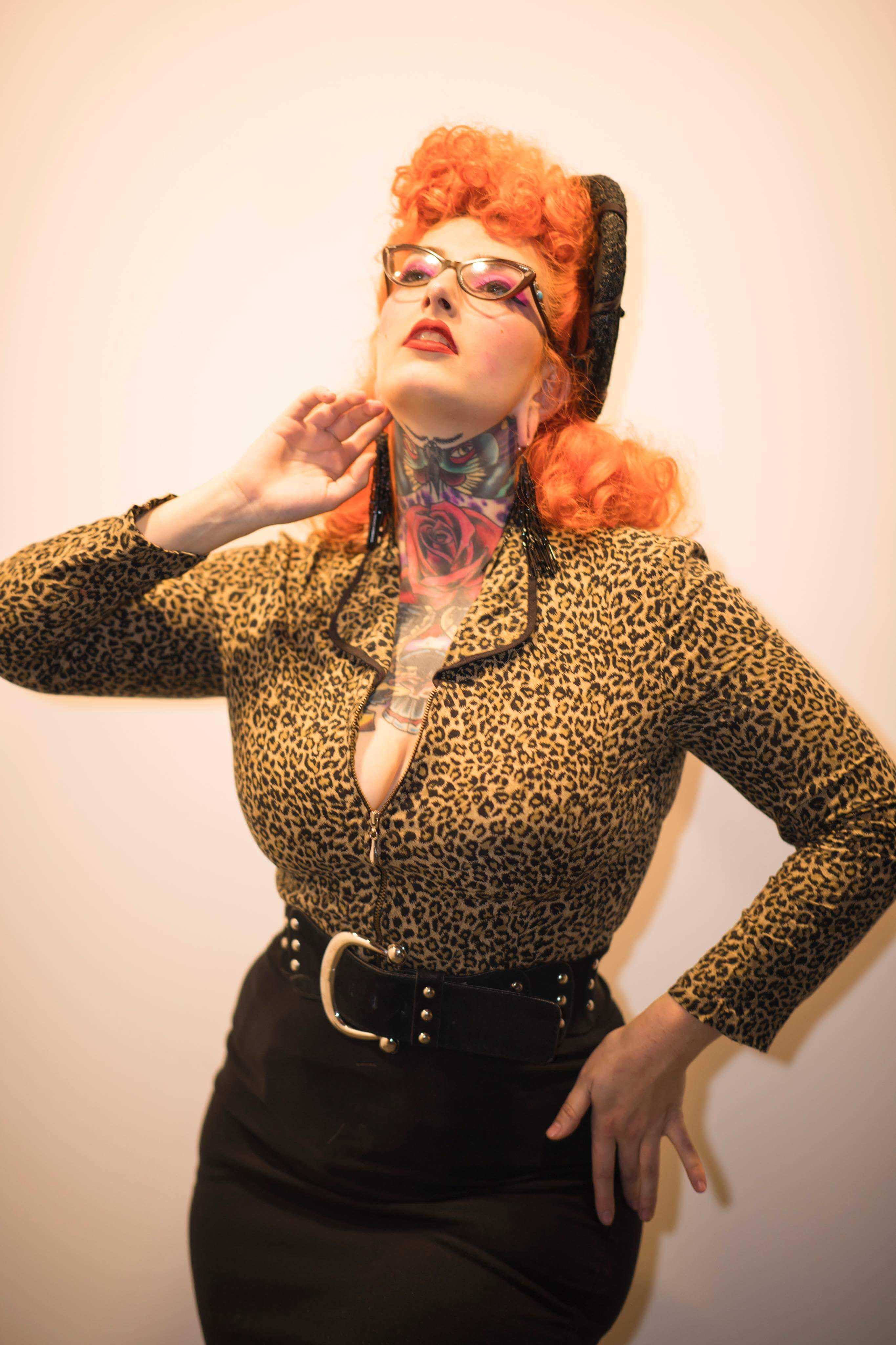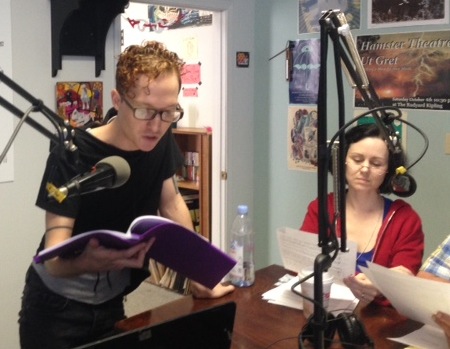Andy Szuran & Paul T. Carney in Chagall in School. Photo: Sean Moth.
Chagall in School
By James Sherman
Directed by David Y. Chack
A review by Keith Waits
Entire contents are copyright © 2024 by Keith Waits. All rights reserved.
Jewish artists are a big topic, and their role at any given time always seems to be interwoven into conflict and change in history. Some were caught in the Holocaust but Hannah Arendt, Max Ernst, Marcel Duchamp, and Marc Chagall made it out through Vichy France and we speak of them today. And if you are an artist and Jew in 2024 you are caught in the reaction to the current war in Gaza, whatever your views. Neutrality is unacceptable.
Before all of that, in the years after the Russian Revolution shook the world and at the behest of the Russian Soviet Republic, Marc Chagall tried to run an art school in Belarus. Vitebsk was his hometown, and Chagall was maybe the most famous artist in Russia.
He assembled an impressive faculty: an anarchic El Lissitsky (Matthew Winner), pragmatic Vera Ermolaeva (Katie Graviss Bechtler), the loquacious Alexander Romm (Eric Moth), and traditionalist Yuri (Yehudah) Penn (Tom Luce) who had once been Chagall’s teacher. I took the painfully introverted David Yackerson (Clinton Nowickie) to be a student more than a teacher since he doesn’t speak, although his movements communicate a great deal.
Act one alternates between richly entertaining scenes of this group interacting at the school and Chagall’s often playful relationship at home with his wife, Berta (Sophia Pietrkowski). The playwright takes these characters seriously enough, but he also allows them to be clever, witty, and silly in ways that communicate their humanity.
The introduction of Kazimir Malevich (Paul T. Carney) the founder of the Suprematist movement, a chilly but graphically striking beginning for abstract art, is the point of conflict in the story. Chagall finds the Supremacist aesthetic abhorrent, as does Yuri Penn – “Would it kill you to paint a banana?” – but Malevich is the sign of the times and his movement quickly becomes the visual representation of the nascent Soviet Republic.
Sherman depicts the movement as sort of a cult, with an absurdly comic series of arm gestures emphasizing the obsessive severity of Supremacism. The key scene of the play is a heated argument between Chagall and Malevich that tidily delineates the shift. Chagall believes artists should be allowed to create what is meaningful to them. Malevich, seemingly in agreement, claims the Bolsheviks gave them the freedom to choose but in the next breath exclaims that, “… artists don’t know what they need. We must tell them!”, revealing the totalitarianism at the heart of Supremacism.
Chagal in School is catnip to anyone interested in art history but also makes intellectual and often abstract ideas highly accessible to a more general audience. The characters are well-drawn and the moment crystallized in a way that illuminates Marc Chagall in larger terms.
All of it is presented through a modern lens, with a contemporary snap to the dialogue. Director David Chack has chosen a cast adept at the timing and delivery to make the most of that quality. They feast on the words and explore the interplay with delight. The scenes of the faculty together were my favorite parts of this production.
I confess I struggled a bit with the domestic relationship between Chagall and Berta. While it is refreshing to see a marriage portrayed as happy and loving, the jokiness felt a little out of place. It was entertaining but at times bordered on facile. A later scene in which Berta uses her sarcastic wit to defend her husband was more impactful. Sophia Pietrkowski does nice work here.
Andy Szuran occupies the center as Chagall, and he doesn’t let his confidence as an actor obscure the painter’s lack of same. Chagall questions himself, and his colleagues speak of his crippling inability to engage with students, but the character does have charisma and Szuran’s best moments are in the debate with Malevich. Paul T. Carney’s self-righteous severity as the Supremacist seems just about perfect. The audience may rightly come to hate him, but he is undeniably compelling.
Simple projections (well managed by Roxell Karr) augment the action onstage with images of the art produced by all of these individuals. As good as the words are, this is an essential ingredient in the audience’s engagement. Chagall in School is certainly “green vegetables” but it never fails to be entertaining. I would be surprised if you don’t Google these names after leaving the theatre and enjoy your own enlightenment. History is fluid, or at least our understanding of it is, and the play gives nuance to a moment in time that is cataloged in our collective memory with only broad swipes (too many viewings of Dr. Zhivago). The Russian Revolution. The Bolsheviks overturn the Czarist regime and the USSR is born. Simple. But even a Wikipedia reading illustrates that the events that resulted in the USSR of the Red Scare, McCarthyism, the Blascklist, and the Cold War are far more complex and bloody.
The theme of Jewish identity explored here is less personal, instead, it is couched in the elusive promise of the Soviet intention to be a safe haven for Russian Jews, a place of freedom and an opportunity to develop and enrich Jewish culture. It was a short-lived Utopian ideal, as the death of Vladimir Lenin and the rise of Josef Stalin would return to the anti-semitism and purges of the Jewish population in violent and uncompromising terms. Sherman includes a brief but sobering coda about the fate of all of these characters that drives the point home. Chagall lived a very long life, and he died in 1985. He was the lucky one.
Featuring Katie Graviss Bechtler, Paul T. Carney, Erik Moth, Clinton Nowickie, Sophia Pietrkowski, Bernadette Stone, Andy Szuran, & Matthew Winner
Chagall in School
February 9, 10, 14, 15, 16, & 17 @ 7:00 pm
February 11 & 14 @ 2:00 pm
ShPIeL-Performing Identity
Kentucky Center for the Performing Arts
501 West Main Street
Louisville, KY 40202
shpielperformingidentity.com
Keith Waits is a native of Louisville who works at Louisville Visual Art during the days, including being the host of Artists Talk with LVA on WXOX 97.1 FM / ARTxFM.com, but spends most of his evenings indulging his taste for theatre, music, and visual arts. His work has appeared in LEO Weekly, Pure Uncut Candy, TheatreLouisville, and Louisville Mojo. He is now Managing Editor for Arts-Louisville.com.





